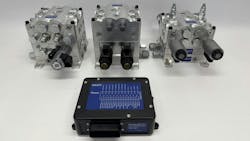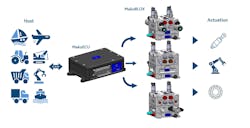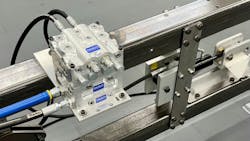New Development Kit Aims to Ease Hydraulic System Design
What you'll learn:
- The components contained in the Mako Hydraulics development kit.
- Why a development kit is beneficial to the hydraulics industry.
- How parts availability aids the development process.
Engineering services company DavisNicols has created a development kit known as Mako Hydraulics to help overcome some of the challenges associated with designing hydraulic systems.
The kit is comprised of two key components:
- MakoECU – an advanced electronic hydraulic circuit controller.
- MakoBLOX – a set of layered manifold blocks.
“We've been developing hydraulic systems for the last 10 years, and really wanted to address some of the things we feel make designing hydraulics difficult,” said Jonathan Nicols, President and Co-Founder of DavisNicols.
He said the aim of Mako Hydraulics is to help both new generations of hydraulic designers and existing ones develop and iterate faster.
“Having designed quite a bit of electronics in my career and worked in electrical engineering, I think they do a better job in that industry of breadboarding and creating development kits, allowing you to explore components and options much quicker and easier than [has been] our experience in hydraulics,” he explained.
Mako Hydraulics brings this concept of a development kit to the hydraulics industry by providing a modular, rapid-development platform which streamlines the design, testing, validation, and deployment of hydraulic motion control circuits.
Integrated Control Knowledge and Configurable Manifold Reduce Development Time
The Mako Hydraulics platform provides users with an electronic control unit (ECU) and manifold blocks which have controls and features already built in to help ease the development process.
Nicols explained that historically when his company has worked with customers, it has been tasked with designing “a fairly sophisticated control system with hydraulics, and we end up developing a circuit and custom manifolds.”
This typically requires writing code and utilizing real-time prototyping tools, all of which can take a lot of time during the development process. Offering a kit which already includes the necessary controls and manifold blocks minimizes the need for generating code and prototypes, helping to lower overall development time.
MakoECU
Basic motion control features, diagnostics and some functional safety are built into the MakoECU’s code so design teams do not have to recreate as much work said Nicols. He also noted that the ECU can be pre-configured to control any of the circuits created with the MakoBlox.
By essentially having all necessary control knowledge baked into the device, users can be assured the ECU will work right away and move on to other aspects of the design process where their expertise may be better suited. They can also benefit from having diagnostics and other capabilities built-in as well.
“It can do a lot of those things that, in reality, don’t get done well when you’re in the development phase like diagnostics, functional safety or proper sensor processing,” said Nicols. “Having been through many prototyping projects, all these things are not done well because it’s not the core functionality. When you’re developing, you’re always focusing on whether the thing works.
“I think we add a lot of value [because] you can do a lot of testing and data collection; you don't have to create that, it already comes with [the ECU],” he said.
MakoBLOX
MakoBLOX is a manifold unit designed to provide the compact size and minimal leak paths commonly associated with custom manifolds and is made up of three layers of manifold blocks:
- Backplane – the bottom block which provides pressure and tank distribution.
- Control BLOX – middle block where flow and pressure valve control are selected.
- Multi-function BLOX – the top block which provides pressure relief, anti-cavitation, and other controls dependent on requirements of the circuit being controlled.
Nicols said that between the ECU with its integrated hydraulic controls and the manifold, “there’s lots of circuits you can breadboard and test with these three fundamental [manifold blocks].”
The manifold is modular in design so it can easily be configured as desired to suit specific test and design requirements. It also supports the use of hydraulic valves commonly found in the market, further easing development time by enabling customers to utilize components which are readily available.
While the ECU and manifold blocks are designed to be used together as a full kit, they can be used independently as well. For instance, customers could use just the ECU if they already have a manifold design or the form factor of the Mako Hydraulics version does not fit the space allotted in an application. Nicols said the MakoBlox are a little large because they are designed to do so much and therefore may be better suited for the prototyping portion of the development phase.
The MakoBlox can be used without the ECU as well. In a test lab, for example, there may already be a programmable logic controller (PLC) system utilized to drive the various test rigs. It would be possible then to just use the manifold blocks.
Parts Availability is a Key Part of the Development Equation
Another important aspect of what DavisNicols hopes to offer through its Mako Hydraulics development platform readily available components. By working with its suppliers, the company aims to carry enough inventory of the MakoECU and MakoBlox so customers can reduce design iteration time.
“Lead times kill…and are the number one problem for hydraulics development,” said Nicols. He noted that the iteration loop can take as long as 12 months, which can be challenging for a business, particularly startups who may not be able to last that long.
“We're hoping that by setting people up with basic software so they don't have to recreate it, having parts in stock, and having circuits [built in] that we're alleviating some of that pain point in the development process,” he said.
Nicols said the company’s goal is to have customers up and running in 4 weeks or less by having the necessary components in stock or working with its suppliers to get the components within that timeframe. He said DavisNicols works with non-traditional machine shops which are willing and able to quickly produce its manifold blocks.
“As long as we have the programs written, the fixtures and the tooling, they can react quickly and get parts on the mills and done relatively quickly if we don't have the particular manifold block in stock,” he explained.
Learn more about hydraulic manifold design in the article "Tips and trends in manifold circuits."
The Mako Hydraulics development platform can be used for hydraulic system development in just about any application, including mobile equipment and test rigs. While it is geared toward use in earlier development stages, Nicols said the controller and manifold are built to be production quality so could potentially be used in a final design, depending on the application.
He concluded by saying the kit came out of his company’s own journey and learnings from developing hydraulics systems “and we hope that people see value in this and that it helps them develop hydraulics as well.”
About the Author
Sara Jensen
Executive Editor, Power & Motion
Sara Jensen is executive editor of Power & Motion, directing expanded coverage into the modern fluid power space, as well as mechatronic and smart technologies. She has over 15 years of publishing experience. Prior to Power & Motion she spent 11 years with a trade publication for engineers of heavy-duty equipment, the last 3 of which were as the editor and brand lead. Over the course of her time in the B2B industry, Sara has gained an extensive knowledge of various heavy-duty equipment industries — including construction, agriculture, mining and on-road trucks —along with the systems and market trends which impact them such as fluid power and electronic motion control technologies.
You can follow Sara and Power & Motion via the following social media handles:
X (formerly Twitter): @TechnlgyEditor and @PowerMotionTech
LinkedIn: @SaraJensen and @Power&Motion
Facebook: @PowerMotionTech

Leaders relevant to this article:





